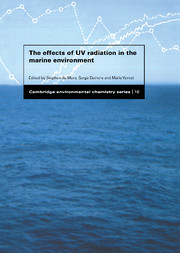Book contents
- Frontmatter
- Contents
- Contributors
- Preface
- 1 Enhanced UV radiation – a new problem for the marine environment
- 2 UV physics and optics
- 3 Spectral weighting functions for quantifying effects of UV radiation in marine ecosystems
- 4 Marine photochemistry and its impact on carbon cycling
- 5 Photochemical production of biological substrates
- 6 Mechanisms of UV damage to aquatic organisms
- 7 Strategies for the minimisation of UV-induced damage
- 8 UV radiation effects on heterotrophic bacterioplankton and viruses in marine ecosystems
- 9 Effects of UV radiation on the physiology and ecology of marine phytoplankton
- 10 Impact of solar UV radiation on zooplankton and fish
- 11 Implications of UV radiation for the food web structure and consequences on the carbon flow
- Index
4 - Marine photochemistry and its impact on carbon cycling
Published online by Cambridge University Press: 20 August 2009
- Frontmatter
- Contents
- Contributors
- Preface
- 1 Enhanced UV radiation – a new problem for the marine environment
- 2 UV physics and optics
- 3 Spectral weighting functions for quantifying effects of UV radiation in marine ecosystems
- 4 Marine photochemistry and its impact on carbon cycling
- 5 Photochemical production of biological substrates
- 6 Mechanisms of UV damage to aquatic organisms
- 7 Strategies for the minimisation of UV-induced damage
- 8 UV radiation effects on heterotrophic bacterioplankton and viruses in marine ecosystems
- 9 Effects of UV radiation on the physiology and ecology of marine phytoplankton
- 10 Impact of solar UV radiation on zooplankton and fish
- 11 Implications of UV radiation for the food web structure and consequences on the carbon flow
- Index
Summary
Introduction
Dissolved organic matter (DOM) in seawater is present at concentrations of about 0.5–2mgl–1 or 0.5–2ppm (MacKinnon, 1981) and represents one of the largest reservoirs of organic carbon on the surface of the earth (Mopper & Degens, 1979; Hedges, 1992). Despite the size of this carbon pool, only about 25% to 50% has been characterised (Zika, 1981; Druffel, Williams & Suzuki, 1989; Benner et al., 1992). In surface waters, the characterised fraction consists mainly of biomolecules that are rapidly turned over by the biota (Lee & Wakeham, 1988; Kirchman et al., 1991; Amon & Benner, 1994). The uncharacterised fraction, >50% of the DOM, consists largely of heteropoly-condensates derived from in situ and terrestrial sources (Ehrhardt, 1984; Harvey & Boran; 1985; Brophy & Carlson, 1989; Ishiwatari, 1992; Lee & Wakeham, 1992; Tranvik, 1993; Heissenberger & Herndl, 1994). These substances appear to be biologically refractory, especially in the deep sea (Barber, 1968; Menzel, 1974; Williams & Carlucci, 1976; Carlucci & Williams, 1978), where they have an apparent mean 14C age of about 6000 years (Williams & Druffel, 1987; Bauer, Williams & Druffel, 1992), which is approximately 12-fold greater than the oceanic deep water replacement time (Stuiver, Quay & Ostlund, 1983). Despite this apparent biological inertness, the pool of uncharacterised DOM is the strongest light-absorbing component of seawater, especially in coastal regions (Højerslev, 1982) and, therefore it plays a dominant role in marine photochemical and photophysical processes (Zika, 1981, 1987; Zafiriou, 1983; Zafiriou et al., 1984; Zepp, 1988; Miller, 1994; Zepp, Callaghan & Erickson, 1995; Blough, 1996; Moran & Zepp, 1997), which in turn impact on biogeochemical cycling of elements in the sea (Kieber, McDaniel & Mopper 1989; Kieber, Zhou & Mopper, 1990; Mopper et al., 1991; Miller & Zepp, 1995; Bushaw et al., 1996; Miller & Moran, 1997).
- Type
- Chapter
- Information
- The Effects of UV Radiation in the Marine Environment , pp. 101 - 129Publisher: Cambridge University PressPrint publication year: 2000
- 52
- Cited by



